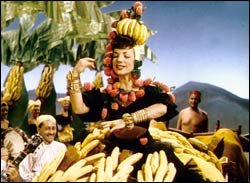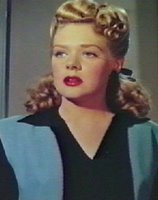 The Gang's All Here (1943)
The Gang's All Here (1943)Director: Busby Berkeley
If the movies had not had Busby Berkeley, they certainly would have had to invent him. The medium of film was made for visual dazzle, and nobody dazzled them like this spectacle-loving director and choreographer. I can just imagine him as a boy, twisting the end of a toy kaleidoscope he had just received for his birthday, lifting his eye above the spyhole, and visualizing the room around him cracking and tumbling in on itself in gay abandon. Indeed, in The Gang's All Here, a late entry in Berkeley's oeuvre and his first film in Technicolor, the final hallucinatory musical number, "The Polka Dot Ballet," breaks into a kaleidoscopic image that prefigures the psychedelia of the 1960s.
Before we reach this ultimate abstraction of human form, which I will elaborate on later, Berkeley weaves some of the most over-the-top musical routines of his
 career into his soldier boy-meets-chorus girl story. Alice Faye plays the sweet Edie Allen, who, while doing her patriotic duty dancing with soldiers on leave at the USO canteen, falls for Andy Mason (James Ellison), a sergeant with a fiancee he neglects to tell her about. He ships out the next day and when he returns a hero, his rich father (Eugene Pallette) arranges for the entire floor show from the Club New Yorker--where Edie works--to do a welcome-home show for Andy at the estate of the Potters (Edward Everett Horton and Charlotte Greenwood), the parents of Andy's fiancee Vivian (Sheila Ryan). Of course, a misunderstanding ensues, but it all comes right in the end. And boy, what an end!
career into his soldier boy-meets-chorus girl story. Alice Faye plays the sweet Edie Allen, who, while doing her patriotic duty dancing with soldiers on leave at the USO canteen, falls for Andy Mason (James Ellison), a sergeant with a fiancee he neglects to tell her about. He ships out the next day and when he returns a hero, his rich father (Eugene Pallette) arranges for the entire floor show from the Club New Yorker--where Edie works--to do a welcome-home show for Andy at the estate of the Potters (Edward Everett Horton and Charlotte Greenwood), the parents of Andy's fiancee Vivian (Sheila Ryan). Of course, a misunderstanding ensues, but it all comes right in the end. And boy, what an end!This solid cast, led by the luminous Miss Faye, takes delight in the comic moments that serve as just a bit more than matchbooks fitted under the off-kilter legs of Berkeley's fever dream. An especially good moment occurs when the wife of straightlaced Peyton Potter reveals herself to be former chorus girl Blossom Murphy upon encountering the director of the nightclub show, Phil Baker, playing himself. They go from the most proper formality to a dance that ends with Potter catching them doing a suggestive dip.
More comic relief is provided on and off the dance floor by Carmen Miranda at her fruity best. Her midriff is bared (but her belly button discreetly hidden by flesh-colored cloth) and her head is piled high with fruits and baubles as she shuffles through a series of forgettable songs. Miranda seems comfortable embodying the stereotypical Latina, whose words never match and whose wardrobe and elbow-high bangle bracelets seem likely to topple her off her skyscraper platform shoes. She is oddly sexless, almost screaming drag queen. She wears thin fast.
Alice Faye could sing the Federal Register and bring you to an emotional peak. She has three numbers in this film, all forgettable songs made memorable by her delivery, particularly "No Love, No Nothin." She's a fabulous movie star whose shine has faded considerably over the years. It's a shame. She deserves to be better remembered.
 But, of course, the screaming star of the show is Berkeley's choreography. "Lady in the Tutti-Frutti Hat," must boast the largest collection of bananas ever committed to the silver screen. As is typical of Berkeley, why hire 10 dancers when you can have 50, or start a musical number with one organ grinder and monkey, unless you end it with a dozen? In between, put a banana-clad Carmen Miranda among the bevy of chorus girls, have her play a banana xylophone, and finish with her standing in front of a backdrop that shoots an enormous fan of bananas out the top of her head. What could be more obvious?
But, of course, the screaming star of the show is Berkeley's choreography. "Lady in the Tutti-Frutti Hat," must boast the largest collection of bananas ever committed to the silver screen. As is typical of Berkeley, why hire 10 dancers when you can have 50, or start a musical number with one organ grinder and monkey, unless you end it with a dozen? In between, put a banana-clad Carmen Miranda among the bevy of chorus girls, have her play a banana xylophone, and finish with her standing in front of a backdrop that shoots an enormous fan of bananas out the top of her head. What could be more obvious?Believe it or not, "Tutti-Frutti Hat" is a more traditional number for Berkeley. When he reaches the final production number, he passes through the looking glass. He begins with Faye performing "The Polka Dot Polka" among a group of dancing children dressed in polka-dotted clothes. Almost ominously, Faye sings "The polka is gone, but the polka dot lives on." We then watch the chorus girls slip in and out of neon circles and then move like a synchronized swimming team with gigantic polka dots as props. Berkeley runs their movements in reverse at one point, a favorite trick of musicals directors. Just when we think the acid trip is over, he has the diembodied heads of all the principal actors appear one at a time in the middle of a polka dot singing the movie's signature love song, "A Journey to a Star," starting hilariously with the bullfrog voice of Pallette. We learn that Faye and Ellison are together when we see them in the same polka dot at the very end. In this way, Berkeley cleverly avoids the cliched final clinch, while turning the entire cast into his version of the night sky to parallel the song lyrics.
The songs in the film have among the worst lyrics I've ever heard. The Benny Goodman Orchestra is featured prominently, and maybe Berkeley thought he was doing Benny a favor by letting him sing a couple of songs. Although I was interested in hearing Goodman's singing voice, heretofore unknown to me, did he really have to say, "Paducah, Paducah, if you want to, you can rhyme it with bazooka"? He fares a bit better in "Minnie's in the Money," and I enjoyed watching the dancers do the jitterbug for all it's worth.
This movie has a lot of so-bad-they're-awful moments, but you can't help but laugh. This is not a good musical, but it is still a must-see. You won't really believe it until you see it for yourself. l


4 Comments:
At 11:59 PM, Anonymous said…
Anonymous said…
Has the movie been released on DVD yet? I have never seen it, a situation I find very frustrating.
I love that you appreciate Alice Faye, a wonderful performer.
And Carmen Miranda, while obviously an icon due to her outrageous headgear and heavy accent, has a warm, generous quality I've always responded to. As a result, something endearingly human comes across, and so makes her more than simply a camp artifact.
At 9:41 AM, Marilyn said…
Marilyn said…
I don't usually review films not available for home viewing. I'm checking to see if a source I know of might have it.
Miranda does seem more than camp as a personality. In this film, she tries to protect Faye from find out about her boyfriend's fiancee, and it seems very sincere. Nonetheless, she set up a pretty damaging stereotype that persists today with Charo at the helm.
At 11:08 AM, Anonymous said…
Anonymous said…
""Lady in the Tutti-Frutti Hat," must boast the largest collection of bananas ever committed to the silver screen."
Well, if you're talking REAL bananas, I think "The Josephine Baker Story" may hold that honor. It's actually a better movie than any made by Ms. Baker.
At 11:38 AM, Marilyn said…
Marilyn said…
I've never seen a movie with Josephine Baker, I don't think, just some clips of her act in various documentaries. She was quite a magnetic performer, I'll say that.
Post a Comment
<< Home